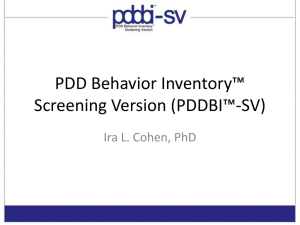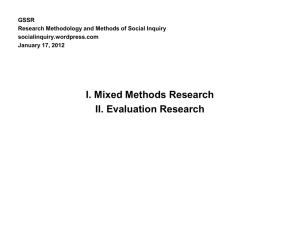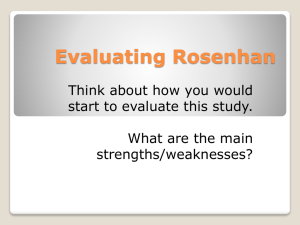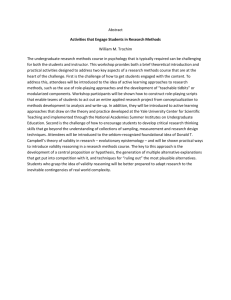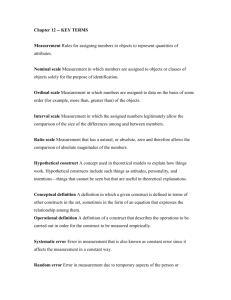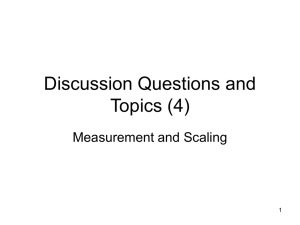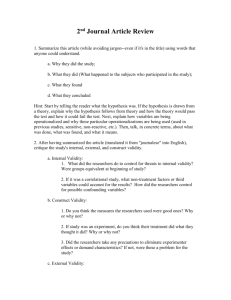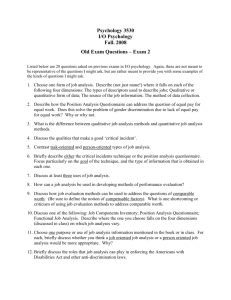Some Aspects of an Individual´s Success Prediction in Sport Bal
advertisement
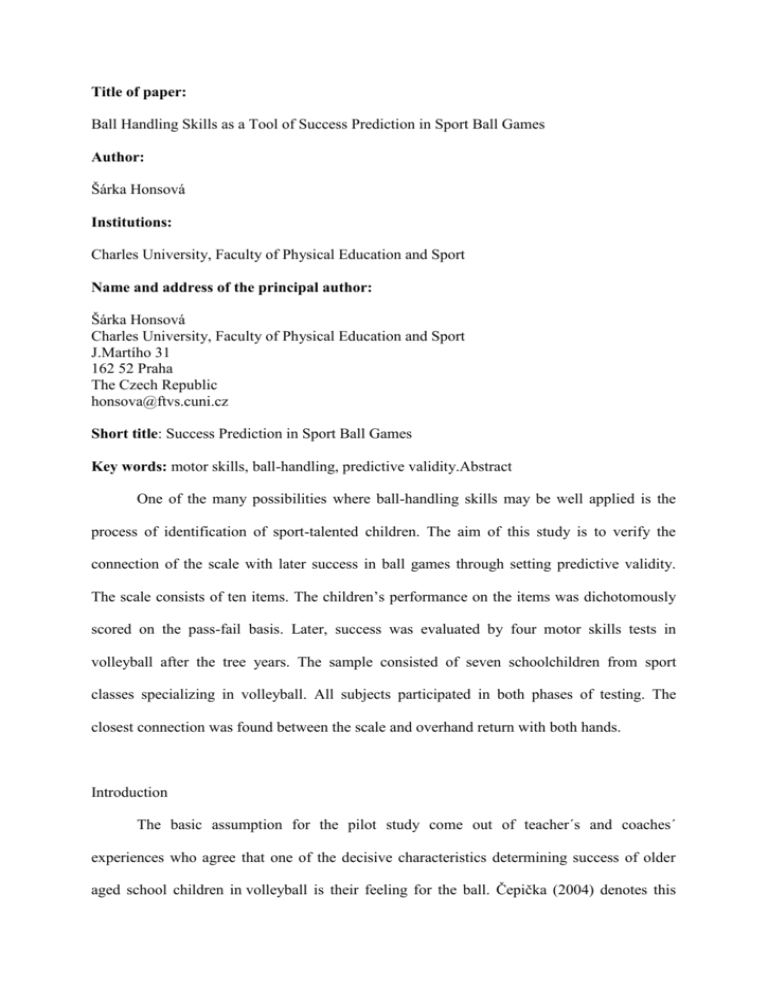
Title of paper: Ball Handling Skills as a Tool of Success Prediction in Sport Ball Games Author: Šárka Honsová Institutions: Charles University, Faculty of Physical Education and Sport Name and address of the principal author: Šárka Honsová Charles University, Faculty of Physical Education and Sport J.Martího 31 162 52 Praha The Czech Republic honsova@ftvs.cuni.cz Short title: Success Prediction in Sport Ball Games Key words: motor skills, ball-handling, predictive validity.Abstract One of the many possibilities where ball-handling skills may be well applied is the process of identification of sport-talented children. The aim of this study is to verify the connection of the scale with later success in ball games through setting predictive validity. The scale consists of ten items. The children’s performance on the items was dichotomously scored on the pass-fail basis. Later, success was evaluated by four motor skills tests in volleyball after the tree years. The sample consisted of seven schoolchildren from sport classes specializing in volleyball. All subjects participated in both phases of testing. The closest connection was found between the scale and overhand return with both hands. Introduction The basic assumption for the pilot study come out of teacher´s and coaches´ experiences who agree that one of the decisive characteristics determining success of older aged school children in volleyball is their feeling for the ball. Čepička (2004) denotes this theoretical concept as qualification for ball-handling, and submits the scale as an empiric indicator for quantification of this concept. The selection of children for volleyball classes consisted of many variables whereby motor tests are its inseparable components. Ball-handling skills represent a very important part of a talented pupil´s profile (Bompa, 1999; Digel, 2001; Reilly et al., 2002). According to Schreiner and Thissen (2001), acquired confidence in ball-handling creates necessary selfconfidence for a game and leads to creative behaviour. A series of tools have been developed for diagnostics of ball-handling skills, motor tests evaluations for established motor skills and evaluation of scales. However, none of the existing tools serves for diagnostics purposes of basic ball-handling skills. Most of these tools aim at specific skills needed in a particular team sport, the preponderance of attention traditionally being on soccer. The intention of the author was to construct a diagnostic tool for estimating basic motor ball-handling skills (Čepička, 2004). The efficiency of the scale to estimate future success in volleyball may be evaluated by assessing a coefficient of predictive validity. The validity of a motor test is always determined with regard to some quantity being measured by the test, the so called criterion. It can be defined as probability of agreement between test result and state of a criterion. Linear validity (i.e. verification of two tests´ relation to explosive power), and nonlinear validity – the example of which is our predictive validity – is being differentiated. The most frequently used validity measure is a coefficient of validity where absolute value of correlation is most often used between test X on one hand and criterion Y on the other. Frequently, it is denoted as Rtc (test, criterion) (Thomas and Nelson, 1996). Predictive validity has a character of future prediction of results. The equation for estimate of criterion Y with only one test X is as follows: y`= a + byx x byx rxy sy sx a yxbyx where a, b are coefficients for estimating performance in the criterion (condition for meeting linear regression conditions). Whether validity of the prediction is sufficient is decided not only by validity but also by determination of coefficient, mainly by error prediction. Coefficient of criterion determination is defined as squared coefficient of combined predictive validity, multiplied by 100%. To decide on a sufficiency, limit performance prediction is important ± dmax ; when 2 dmax = ±2sy|x and middle error of criterion estimate: sy x sy 1rxy Such ranging does not yet mean prediction. Only when the equation is valid in the future may we use it for performance prediction. It is being gradually verified in the so-called predictive verifying cycle. A predictive cycle may be used when performance prediction is used for single selection (i.e., choice of candidates) being repeated in cycles, most often every year. It is assumed that population from which the candidates are annually selected to the entrance tests changes very slowly over time. Cycles are being repeated (i.e. annually) and if the predictive coefficients do not change significantly in the equation, and if the equation validity also remains nearly the same it implies that the predictive equation has stabilized in time. Such a time stable predictive equation can then be used for performance prediction in the future. But if the equation changes irregularly – cycle to cycle, it can not be used for the prediction (Thomas and Nelson, 1996). In our case it concerns a pilot study, so the verifying predictive cycle could not have been realized yet. The most often used criterion for predictive test validity assessment in team sports includes playing performance of the subject assessed under different parameters. Ejem (1980) divides assessment score of playing performance into three groups. In the first group one utilizes subjective methods to assess a player´s performance. Than these subjective results are evaluated against the player´s performance in the game. The second group of methods evaluates performance (or rather efficiency) of a player on the basis of series of matches where all players play against each other. This method, the most easily and frequently used in tennis, is based on the assumption that player´s performance is the main factor influencing the match. The third group utilizes objective observation methods for evaluating a player´s performance during the game. The last method evaluates performance on the basis of objectively measuring qualitative and quantitative items registered during the game. The application of individual game activities is presented as single items, whereas the quality is seen as its effective usage in the game (i.e. the ratio of successfully used game activities to the number of all used activities in the game). We have yet to establish a suitable scale or questionnaire for subjective assessment. However suitable conditions for objective assessment of game performance can not be achieved at school level due to considerable imbalance of game performance level, time and material limits. It was decided to use tests for individual game activities as a criterion. Material and methods As a criterion for setting predictive validity with the rating scale of ball-handling skill assessment according to Čepička (2004), four motor tests for assessment of individual´s game activities in volleyball were chosen: repeated overhand returning of the ball against the wall, placed service, repeated underhand returning of the ball against the wall with a ground bounce and repeated bump pass with both hands without a ground bounce. The first two tests are standardized (Ejem 1980, Tománková1988), while the other two are not and they were only experimentally included. Their description is given in Appendix 1. With these two non- standardized tests, the reliability was assessed by the test-retest method, considering the fact that the test was performed twice and the better result was used for further analysis. We are aware of the short time interval between repetitions of the test and so the reliability assessed by this method will be considered only as rough supplementary data. The sample consisted of 7 elementary school pupils in Plzeň attending a sport classes specializing in volleyball. In March 2OO1, they took part in a calibration of tests where the rating scale was developed. At the time of the testing in June 2004, they were attending 8th or 9th grade of this school, were 13 to 15 years old, 152– 178 cm tall and weighted 53 to 76 kg. By the term predictive validity we denote a correlation coefficient between the scale for ball-handling skill assessment and the criterion of four subsequent motor tests for assessment of individual game activities in volleyball. There was an interval of three years and three months between scale testing and criterion. The Pearson´s coefficient of product correlation was used to calculate correlation coefficient. In deciding if predictive validity was sufficient, the limit error for performance prediction was calculated. Data processing was done with the use of Microsof Excel 2000 program (NCSS&PASS 2004). Results and Discussion Results of predictive validity calculations are shown in table 1. The highest coefficients of predictive validity can be seen with the test of overhand returning with both hands (rxy = 0.501) and the test of underhand returning with a ground bounce (rxy = 0.512). The limit error of prediction is too high to be satisfied with such performance prediction. For instance, if the limit error of prediction in the test of overhand returning with both hands was 3.86, performance in this test could be estimated with error nearly four returns over the predicted performance and nearly four returns below the predicted performance. The same applies to the test of underhand returning with a ground bounce. All those results can be highly biased by low number of tested subjects. Coefficient of predictive validity is low with the tests of placed service and underhand return with both hands without a ground bounce, and the limit error of prediction is high, so in these cases the performance estimate would be considerably inaccurate. Regarding a minimum time interval between repeating the tests and a minimum number of tested subjects, reliability can be considered only as rough supplementary data. Reliability of the test of underhand return with a ground bounce would not be satisfactory, whereas the reliability of the test of underhand return without a bounce would be at an acceptability limit. Since the test has a low coefficient of predictive validity and high limit error prediction, the test is not suitable. Conclusions This pilot study mainly served for verifying of methodologies for setting predictive validity with the rating scale for ball-handling assessment. The greatest problem seemed to be in setting the criteria for children’s performance, as well as time and financial limitations during the conductance of the study. A relatively long time interval between scale testing and criteria was an advantage for high-quality setting of predictive validity, but at the same time it considerably lowered the number of pupils participating in both evaluations. With regard to the small sample size we must take into account that all results may be considerably biased. For further recognition of rating scale characteristics for ball-handling skill assessment, it is necessary especially to implement quality criteria to more accurately set the predictive validity. References 1. Bompa, T. O. 1999. Periodization. Theory and Methodology of Training. Champaign: Human Kinetics. 2. Čepička, L. 2004. Assessing ball-handling skill in children using the Rasch analysis. Journal of Human Movement Studies, 46, 155-169. 3. Digel, H. 2001. Talent search and talent promotion in international comparison. Leistungssport. vol. 31, no. 4, p. 72 – 78, (In German). 4. Ejem, M. 1980. The effectivity of training process in volleyball and its evaluation. A methodical paper of ÚV ČSTV (Central Committee of Czech Association of Physical Education). New findings of theory and training in volleyball. Prague: Sportpropag, (In Czech). 5. Hochmann, A. 2001. Diagnostic criteria of performance of sport - talented children. Leistungssport, vol. 31, no. 4, p.14 – 22, (In German). 6. Moravec, R. 2001. The stability of development and predictive validity of selective criterions. In the textbook of international conference Sport in the Czech Republic at the Beginning of the New Millenium, the second volume, Prague 1.2. – 4.2.2001, Prague: FTVS UK (Faculty of Physical Education and Sport, Charles University), (In Czech). 7. Reilly, T., Williams, A., Nevill, A., a Franks, A. 2002. A multidisciplinary approach to talent identification in soccer. Journal of Sports Sciences, 18, 695-702. 8. Schreiner, P. and Thissen, G. 2001. Training of dribbling the ball in a group of three. Fussballtrainer, vol. 52, no. 8, p. 28 – 31, (In German). 9. Tománková, K. 1988. Diagnostics of motor skills through the use of motor tests in physical education at university. Thesis. Prague: FTVS UK, (In Czech). 10. Thomas, J. R. and Nelson, J. K. 1996. Research methods in physical activity. Champaign: Human Kinetics. 11. Ziemainz, H. and Gulbin, J. 2001. Searching, selection and support of talented children in the example of Australian program TALENT SEARCH. Leistungssport. vol. 31, no. 6, p. 43 – 46, (In German). Appendix 1 Description of nonstandardized tests Test of repeated underhand return with a ground bounce Test stems from the test of repeated overhand return by both hands. Equipment: Fixed smooth wall 3m wide and 5m high with marked line at the height of a net (men 2.43cm, women 2.24), there is a free space in front of the wall 3x4 m, where a line is marked at a distance 1.5m for women and 2.20m for men, volleyball ball, stopwatch. Execution: The tested subject is standing face to the wall, volleyball ball ready in the hands. The subject throws the ball against the wall so that it bounces off the restricted area over the line at the height of a net and the bounced ball is repeatedly returned after each bounce on the ground underhand until the timekeeper stops the test. Height of returning is not determined. The tested subject must not step over the line limiting distance from the wall when returning the ball (1.5m women, 2.20m men). The task is to perform the highest possible number of returns within 30 seconds. Record: Test is performed twice and the better result is recorded. The result of the test is set as the number of correct returns performed within 30 seconds. The tested subject scores one point whenever the ball touches the wall inside the restricted area over the line at net height. Thrown balls, as at the beginning of testing and whenever interrupted, are not counted as points. Test of repeated underhand return by both hands against a wall The conditions, performance and evaluation are the same as in the previous test, only there is no ground bounce before the return of the ball. Table 1 The results of predictive validity calculation Test – criterion mean SD rxy Limit error prediction ± dmax Overhand return with both hands 30.86 2.23 0.501 ±3.86 Placed service 7.14 1.46 0.086 ± 2.91 Underhand return both/hands with a ground fall 11.29 1.03 0.512 ± 1.77 Underhand return both/hands without a fall 21.29 3.45 0.297 ± 6.59 SD = standard deviation rxy = coefficient of product correlation between rating score for motor ball-handling skill assessment and criterion Table 2 The results of reliability calculation through stability coefficient Test rstab Underhand both hand return with a bounce 0.327 Underhand both hands return without a bounce 0.731
